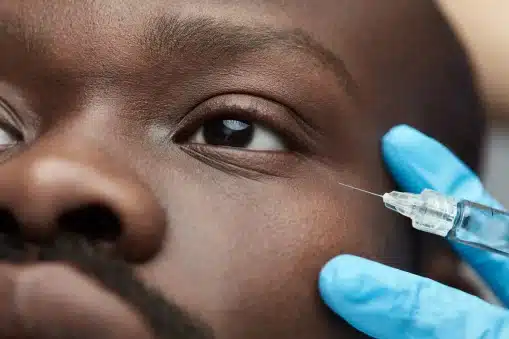Dermal fillers are not just a passing trend; they are the single most significant advancement in non-surgical cosmetic procedures. With various options available—from hyaluronic acid to collagen-based fillers—these treatments offer customizable solutions that can be tailored to everyone’s needs.
Knowing what to anticipate can alleviate fear and set realistic expectations, ultimately enhancing patient satisfaction.
We will dive deep into the preparation, procedure, and aftercare involved with dermal fillers to equip you with the necessary knowledge. Whether you’re looking to understand the differences between different filler types, learn about potential risks and side effects, or explore how to maximize the longevity of results, we’ve got you covered.
Let’s explore everything you need to know about dermal fillers before and after, which will be valuable for both seasoned professionals and those new to the world of cosmetic enhancements.
Dermal Fillers 101
These injectable substances are designed to add volume, contour, and improve the overall appearance of the skin, thus addressing signs of aging or enhancing natural features.
Types of Dermal Fillers
There are many different types of fillers.
Hyaluronic Acid (HA) Fillers
Hyaluronic acid is a naturally occurring substance in the skin that helps retain moisture and volume. HA fillers are popular due to their versatility and immediate, natural-looking results.
Most Famous Brands: Juvederm, Restylane, Belotero
Benefits:
- Immediate plumping effect
- Hydrates and revitalizes the skin
- Reversible with hyaluronidase
Longevity: Typically lasts 6-18 months
Calcium Hydroxylapatite Fillers
Calcium hydroxylapatite is a mineral-like compound naturally found in human bones. These filters can stimulate natural collagen production.
Most Famous Brands: Radiesse
Benefits:
- Provides immediate volume
- Stimulates collagen production for longer-lasting results
- Ideal for deeper wrinkles and facial contouring
Longevity: Results can last up to 12 months or more
Poly-L-Lactic Acid Fillers
Poly-L-lactic acid is a biodegradable synthetic substance that stimulates collagen production. These filters are used for gradual, natural-looking improvements.
Most Famous Brands: Sculptra
Benefits:
- Gradual and subtle results over several months
- Long-lasting improvement in skin texture and firmness
- Effective for large-volume restoration
Longevity: Effects can last up to 2 years
Collagen-Based Fillers
Collagen fillers, derived from bovine or human sources, were among the first injectable fillers used in cosmetic dermatology. While less common today, they still offer benefits for certain patients.
Benefits:
- Immediate improvement in skin texture and volume
- Smooths out fine lines and wrinkles
Longevity: Typically lasts 3-4 months
Indications for Dermal Fillers
Dermal fillers are used to address a variety of cosmetic concerns.
- Volume Loss: Restoring volume in areas like the cheeks, temples, and under the eyes.
- Wrinkle Reduction: Smoothing out fine lines and deeper wrinkles.
- Facial Contouring: Enhancing facial features like lips, chin, and jawline.
- Scarring: Improving the appearance of certain types of scars, including acne scars.
Benefits of Dermal Fillers
Some of the main dermal filler benefits are:
- Non-Surgical: Provides an alternative to invasive surgical procedures with minimal downtime and risk.
- Immediate Results: Most fillers give instant improvement in facial volume and contour.
- Customizable: Treatments can be tailored to individual patient needs and desired outcomes.
- Minimal Downtime: Patients can typically resume normal activities shortly after treatment.
Preparation and Care for Dermal Fillers Before and After
Preparation before receiving dermal fillers is crucial.
During this first meeting, the clinician will evaluate various factors to determine the patient’s suitability for the procedure.
- Medical History Review: It is essential to understand the patient’s complete medical history, which includes current medications, chronic conditions, past surgeries, and any history of allergic reactions.
- Cosmetic History: Reviewing previous cosmetic procedures helps in planning the current treatment.
- Aesthetic Goals: Discussing the patient’s aesthetic goals and expectations allows the clinician to make the plan.
Allergies, pregnancy, nursing, bleeding disorders, or autoimmune diseases are considered contraindications.
Also, educating patients about the treatment process, potential side effects, and aftercare is important.
Procedure Overview
Sometimes, providing a detailed explanation of the injection process may seem irrelevant to the layman, but it’s actually not.
The procedure starts with cleaning. The treatment area is thoroughly cleansed with an antiseptic solution, removing any makeup or skincare products.
Then, the clinician uses a marker to outline the areas where the dermal filler will be injected.
Various forms of anesthesia or numbing agents make the patient comfortable. A numbing cream containing lidocaine or a similar agent is applied to the treatment area 20-30 minutes before the injections. Sometimes, local anesthesia is injected into the treatment area to provide total numbness, especially for more sensitive areas or extensive treatments.
Injection Process
Fine-gauge needles are commonly used for their precision and ability to minimize trauma to the skin. Blunt-tipped cannulas may be used in certain areas to reduce the risk of bruising and swelling.
Fillers are injected at different depths and layers of the skin to achieve natural-looking results. The clinician may massage and mold the filler after each injection to distribute the filler and smooth contours.
Treatments focusing on one area, like lip augmentation, may take as little as 15-30 minutes. More extensive procedures may take 45-60 minutes or longer.
After the injections are complete, a brief evaluation is a must. The clinician assesses the treated areas for symmetry and balanced volume. Any necessary adjustments can be made immediately to refine the results. Patients are also given a mirror to view the immediate results.
Immediate Post-Treatment Period
Proper care during the first days can significantly influence the overall success of dermal filler treatments.
Applying cold compresses and keeping the head elevated reduces swelling and redness. Using gels can also reduce bruising.
Certain activities, mostly strenuous physical activities, should be avoided for at least 24-48 hours post-treatment. Physical exertion can increase blood flow to the face, potentially worsening swelling and bruising. The same goes for hot environments such as saunas, steam rooms, and hot baths.
Patients should avoid touching or massaging the treated areas and sleep on their backs.
Skincare Regimens
Use a mild, non-abrasive cleanser to keep the skin clean without irritating. Apply a gentle, hydrating moisturizer to soothe the skin. Protecting the skin from UV exposure is paramount. Patients should use a broad-spectrum sunscreen with at least SPF 30 daily, even if they plan to stay indoors.
Short-Term Results (Days to Weeks)
The short-term results of dermal filler treatments are visible over several days to weeks. Gradual improvements can be seen as the filler settles and integrates with the surrounding tissues.
Areas treated with dermal fillers will exhibit an immediate increase in volume and definition. Still, patients must be patient with the final result since mild to moderate swelling peaks within the first 48 hours before gradually subsiding. Similar is with redness.
As the days progress, the filler integrates with the surrounding tissues. Any firmness softens, and the skin’s texture improves.
Drinking plenty of water supports overall skin health and helps the filler integrate smoothly.
An initial follow-up visit is typically scheduled within two weeks to assess the results and ensure proper healing. Further follow-up appointments may be necessary depending on the type of filler and individual response. Then, a maintenance plan can be discussed.
Long-Term Results (Months to Years)
As we explained above, the longevity and effectiveness of dermal fillers vary significantly based on the type of filler used. So, understanding the long-term trajectory of these treatments is the way for patients and practitioners to set realistic expectations and plans.
We must not forget individual metabolic factors and lifestyle choices.
Aesthetic interventions do not mean that skincare loses its importance. Regular use of hydrating products helps maintain the plumping effect of fillers. Incorporating antioxidant-rich serums can protect the skin from free radical damage and support overall skin health.
A diet rich in vitamins and minerals also supports skin health and prolongs the effects of fillers. Regular physical activity improves circulation and skin vitality, as well.
Regular maintenance treatments, scheduled every 6 to 12 months, play a key role in making the results of dermal fillers practically permanent.
Can Dermal Fillers Be Safely Removed or Reversed?
Yes, hyaluronic acid fillers can be dissolved using hyaluronidase, an enzyme that breaks down HA molecules. This reversal procedure effectively corrects overfilling or irregularities, restoring facial symmetry and patient satisfaction. Collagen-stimulating fillers, however, require time to dissipate naturally.
Wrapping Up
Dermal fillers have revolutionized aesthetic medicine, providing safe, effective, and minimally invasive solutions.
As cosmetic dermatology continues to advance, ongoing research and innovation in filler technology are paving the way for even more effective and longer-lasting solutions. New developments promise enhancements in safety, efficacy, and patient comfort, ensuring that aesthetic professionals and consumers access the latest and most effective treatments.
For those considering dermal fillers, always stay informed about the latest advances and remember what to expect before, during, and after treatment. With the information from this article and expert guidance, achieving desired aesthetic goals is more attainable than ever.
Frequently Asked Questions (FAQ)
Are there any age restrictions or guidelines for receiving dermal filler treatments?
While there isn’t a specific age limit for dermal filler treatments, candidacy is determined more by skin condition and aesthetic goals than age alone. Younger patients may opt for fillers to enhance facial contours or address early signs of aging, while older individuals may seek restoration of lost volume and reduction of deeper wrinkles.
What dietary or lifestyle changes should I consider before and after getting dermal fillers?
Before dermal filler treatment, consider avoiding blood-thinning medications, alcohol, and supplements that may increase the risk of bruising or bleeding. After treatment, maintaining a healthy lifestyle and adequate hydration supports optimal skin recovery and the longevity of results. Nutrient-rich foods and gentle skincare routines promote skin health.
Can dermal fillers be used in combination with other cosmetic procedures?
Yes, dermal fillers are often combined with other cosmetic procedures like Botox (botulinum toxin) or laser treatments to achieve comprehensive facial rejuvenation. Botox can smooth out dynamic wrinkles, while fillers restore lost volume and contour. Laser treatments can enhance skin texture and tone, complementing the effects of fillers.
How do I know if I am a good candidate for dermal fillers?
Good candidates for dermal fillers are generally in good health and have realistic expectations for improving facial appearance. Individuals with sensitive skin or allergies should disclose their medical history during the consultation to assess potential risks. Qualified practitioners can recommend suitable filler types and allergy testing if necessary to minimize adverse reactions.
What advancements or innovations are being made in dermal filler technology that could impact future treatments?
Ongoing advancements in dermal filler technology focus on improving longevity, texture, and safety profiles. Innovations include cross-linked hyaluronic acid for enhanced durability and biostimulatory fillers that promote collagen production over time. Micro-droplet techniques and customizable formulations cater to diverse patient needs, offering precise results and minimal downtime.
References
Wongprasert P, Dreiss CA, Murray G. Evaluating hyaluronic acid dermal fillers: A critique of current characterization methods. Dermatol Ther. 2022 Jun;35(6):e15453. doi: 10.1111/dth.15453. Epub 2022 Apr 5. PMID: 35293660; PMCID: PMC9285697.
Al Mashhrawi YM, AlNojaidi TF, Alkhaldi RA, Alshami NS, Alhadlaq AS. Awareness and Knowledge of the Adverse Effects of Dermal Fillers Among the Saudi Population: A Cross-Sectional Study. Cureus. 2023 Jun 12;15(6):e40322. doi: 10.7759/cureus.40322. PMID: 37448388; PMCID: PMC10337987.



0 Comments